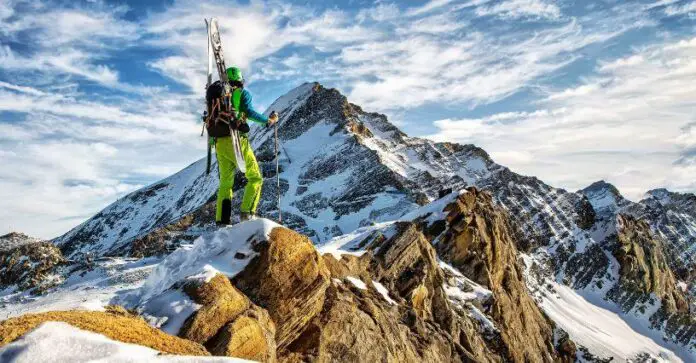A ski backpack is not only a practical place to store winter sports essentials, but also a key element of safety and comfort on the slopes or when skiing off-piste.
Whether you’re a fan of downhill skiing or snowboarding, or prefer to ski touring, a good ski backpack will help you organize, secure your essential gear and ensure your comfort during any activity. Winter.
Find out what features and functions are important when choosing a ski or snowboard backpack .
Ski backpack – why should you buy one?
The ski backpack is a multifunctional and extremely useful piece of equipment for any winter sports and backcountry enthusiast. First, it allows you to safely organize, store and transport essentials such as extra layers of clothing, goggles, helmet, gloves, thermos with hot drink, snacks, gear (ski skins) etc. .
Thanks to properly designed pockets and compartments, you are assured that everything is in its place and easily accessible. You don’t have to worry about forgetting essential accessories and equipment.
Most of the time, ski backpacks are made of waterproof and durable materials that protect the contents from rain and snow, giving you the confidence that your belongings will stay dry in all conditions .
Good ski backpacks have adjustable straps, comfortable hip belts, padding and special reinforcements on the back to ensure that you can wear them comfortably even for long periods of time, even during a strenuous descent or hike in the mountains, without undue effort.
The proper design allows you to move freely on and off the slopes without restricting your mobility like a traditional bag or a city backpack .
Ski or ski touring backpacks usually have a special fastening system that allows the safe transport of equipment when you are not using your skis or snowboard. If you’re planning off-piste expeditions, a ski backpack can offer special safety features like an airbag for avalanche protection and room for a probe and shovel for an eventual rescue.
Some ski backpack designs have built-in hydration systems that make it easy to drink water while skiing or snowboarding, which is important for staying hydrated in the winter. These additions can significantly increase comfort and safety during your expeditions.
In addition, the wide range of colors, patterns and styles make the ski backpack more than just a fashionable winter clothing item. A ski backpack can also be useful outside the ski season, for example: when hiking in the mountains or other outdoor activities.
What to look for when choosing a backpack for skiing, snowboarding or ski touring?
Choosing the right ski backpack can be crucial for comfort and safety during your days on the slopes or in the backcountry.
An adequate capacity, a comfortable and well-adjusted transport system, good organization and easy access to the contents or a robust material resistant to weather and mechanical damage are some of the most important features that a ski or snowboard backpack should have to have them .
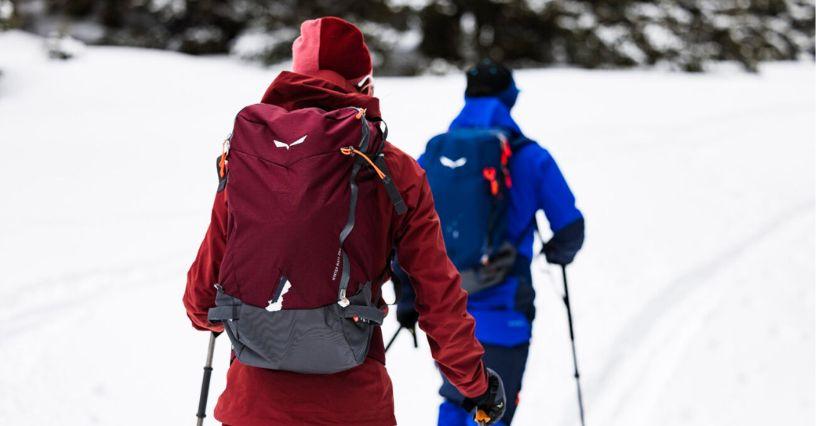
Capacity
First, determine where you will be using the backpack and what type of travel you will be doing with it.
Do you plan to spend your time mainly on the slopes, do you plan to hike in the wilderness or go to remote areas for a few days? How long will you be gone, how much and what additional equipment, accessories and other things will you need to carry out your plans? Will you pack only your luggage in the backpack or do you need a slightly larger capacity to accommodate the change of clothes, supplies and other items needed to hit the slopes with your child ?
The usual sufficient capacity of a ski backpack is :
- 12-20 l – a short stay on the slopes of a ski resort or a quick trip on the cross-country ski slopes ;
- 20-35 l – longer day trips ;
- 35-55 l – multi-day trips with overnight stays in cabins, night hikes and technical climbing on skis ;
- 60-70 l – long-term expeditions that require a tent, cooking accessories and additional technical equipment .
The most versatile solution are ski backpacks with a capacity of 25-40 liters , which are enough for long days in the ski resort or short trips in the backcountry, as well as having space for avalanche equipment, additional layers of clothing , gaskets, first aid kit, food and water.
It’s worth noting that as the capacity of a pack increases, so does the weight of the pack itself, which can be very uncomfortable, especially when touring or ski touring
Material
A waterproof or hydrophobic finish to protect the contents of the backpack from getting wet and soaked, plus durability and resistance to abrasion, scratches, tears, etc.
These are the qualities that a good ski backpack material should have. Ski backpacks are usually made of technical materials: polyester with added polyurethane and TPE (thermoplastic rubber) or ripstop fabric based on nylon or polyester.
It is worth noting that the degree of resistance of the material is measured in deniers (den or D). This measurement refers to the thickness of the individual threads used to produce the fabric.
For example, if a value of 200 denier is indicated in the description, it means that each thread contains 200 threads. The higher the value, the more durable and resistant to various types of mechanical damage the fabric is, but also more expensive .
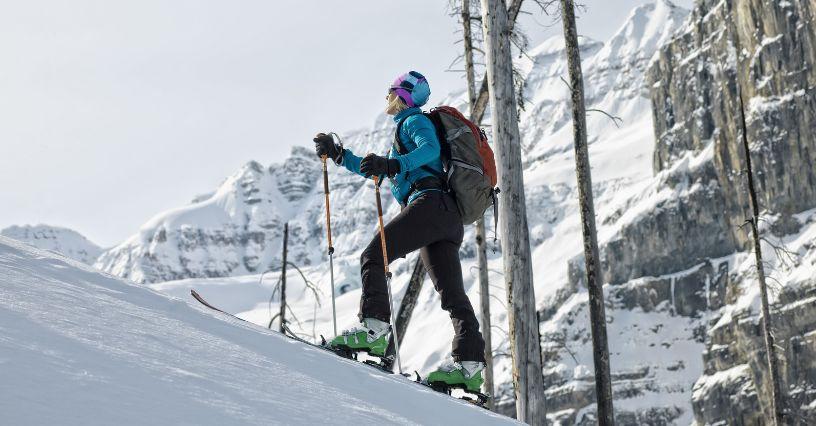
transport system
The carrying system of a ski backpack is a key element that influences carrying comfort, load distribution on the back and hips (minimizes pressure on the spine) and skiing comfort.
Carrying systems usually include hip belts and chest straps to prevent it from shifting during movement. This is especially important when skiing downhill, when stability is essential.
Good harnesses are ergonomic, made of foam or mesh, provide adequate air circulation and allow the length of the harness to be adjusted to suit different silhouettes. Some versions can be equipped with removable back panels .
In the case of women’s ski packs , the hip belt can be better adapted to the female anatomy (women tend to have wider hips than men) and better padded .
Lock system and access to content
Because skiing involves a lot of intensity, it’s important to have easy and convenient access to the contents of your pack without having to take it off and put it back on frequently.
Therefore, when choosing a ski backpack, consider how often you will need to access the equipment during the day and under what conditions.
In addition to the efficient operation of the main compartment, it is a good idea to choose a backpack with several access points, so that you can quickly find your gear in every nook and cranny without having to take anything out.
Most models offer various combinations of closure systems, such as a zipper in the top compartment combined with a side zipper or a zipper on the back/front panel. Which one should you opt for?
If you will be mainly on the slopes and using the chairlift, a U-shaped top zip closure can be a practical choice. Looking for a solution for longer approaches and descents? Try the roll-top closure and side zippers.
Are you one of those speed or endurance ski enthusiasts? An excellent option would be a model that is a combination of backpack and ski vest and has a zipper on the back panel .
Attachment of equipment
Most ski backpacks offer external straps for securing skis or a snowboard , which is especially useful for skitouring, splitboarding or alpine skiing. The most common are two configurations :
- diagonal (or side) – the loops in this configuration allow the skis to be carried diagonally. The best solution for snowboarders, because in most cases it is not possible to attach a snowboard to the A-frame option (except splitboards) ;
- A-frame – with this fastening system, each ski is on one side of the backpack and connected at the top with a rubber strap .
On the market you will find both ski backpacks that support both forms of transport, as well as those that offer only one solution. For example, models with airbags often do not offer the option of an A-frame. If you want to attach a snowboard to your backpack, make sure the model in question will be able to carry it .
Most ski backpacks, especially those dedicated to touring or alpine skiing, have a convenient attachment for an axe, ski helmet, poles or ropes. The external attachment points can also be used in certain situations to easily pull the backpack up with a rope .
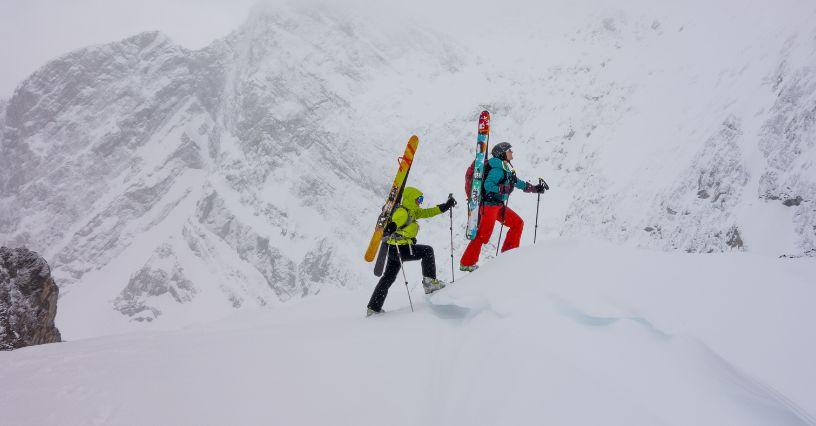
Compression straps
The volume and weight of your pack will change over the course of a day of skiing or snowboarding as you change layers of clothing, reduce supplies, and so on.
To avoid the rucksack becoming heavy once the contents have been reduced, common ski rucksack models have compression straps on the sides, which allow the load to be compressed to a size that fits perfectly on the back and does not hinder further movement .
Pockets and compartments
Internal and external pockets and compartments of ski backpacks provide good organization and storage of ski equipment such as goggles, sunglasses, first aid kit, snacks, emergency equipment, etc.
They are usually zipped up for easy use with winter gloves. In the case of goggles or glasses, the dedicated pockets can be additionally lined with fleece to reduce the risk of scratching the lens and are separated from other storage compartments.
The pocket for avalanche equipment (probe, detector, shovel) is usually waterproof and equipped with the outermost zipper to ensure quick access to the contents in an emergency.
On the waist belt you will also find a pocket for your phone, for example. A slim, mesh compartment is usually used to carry a ski helmet, while the crampons can be stored in a special, sturdy pocket that prevents the rucksack or other materials from being torn by sharp bits.
Are you one of those people who often reach for water during exercise? A good option for you would be a backpack with a hydration system and an insulated sleeve for the hose, so that the drink does not freeze at low temperatures.
When shopping for a backpack, make sure the pockets and compartments you choose are large enough to fit your gear and are easily accessible, regardless of what you might be strapping to the outside of the backpack .
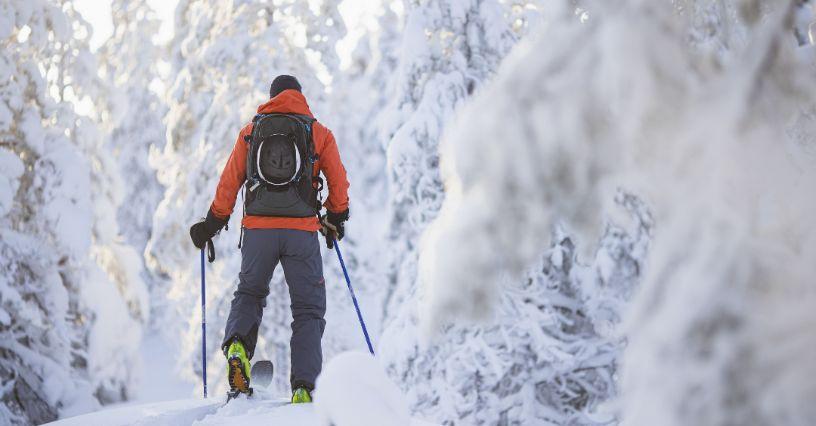
Airbag
One of the dangers of backcountry skiing or freeriding is an avalanche that can drag you deep under the snow, necessitating a difficult and time-consuming rescue operation . To increase your chances of survival, choose a ski backpack with an airbag so you stay close to the surface instead of being pulled under thick layers of snow.
In addition, the airbag has a protective function – it becomes a barrier to protect your head and neck from direct impact with stones, trees or other obstacles . Avalanche backpacks are typically heavier, more expensive, and have limited capacity, but they can also offer the option to remove the airbag mechanism, making them more versatile .
Built-in RECCO system
The RECCO system is a passive locating and searching system designed to increase the chances of finding people who are missing, trapped in the mountains or under avalanches. It consists of a special plate sewn into the rucksack (or outerwear), which, in the event of a dangerous situation, reflects radio waves to the RECCO detector, with which, among others, rescue teams are equipped.
In this way, rescuers can locate people equipped with searchlights. The RECCO system is passive, which means that it does not require the active intervention of the wanted person. No need to press a button or turn on the board .
However, it is worth noting that the RECCO system is not a substitute for common sense and proper preparation for mountain activities. It is always important to follow safety rules, avoid risky situations and equip yourself properly to deal with emergencies or accidents .
Ski touring vs ski backpack – differences
Due to the different purposes and styles of skiing, the classic ski backpack and the touring ski backpack are slightly different. Ski touring backpacks are designed with uphill and off-piste skiing in mind.
They range from minimalist designs with room for avalanche gear and skins to much larger backpacks designed for multi-day wilderness expeditions. They are designed not to restrict mobility and not create additional resistance on descents, while providing sufficient capacity for the necessary equipment.
To make backcountry trips as easy as possible, they have special fastening systems for skis and trekking poles, as well as for storing other ski accessories (probe, avalanche detector, snow shovel, etc.), to keep equipment well organized .
It guarantees comfort and convenience through a good fit on the back thanks to the functional carrying systems and reinforcements, as well as through the efficient evacuation of moisture with the help of modern ventilation systems.
Classic ski backpacks, on the other hand, are designed primarily for traditional cross-country skiing. They are ideal for transporting on the slopes and storing ski equipment such as goggles, gloves, skis or board and possibly spare clothes and food.
It is worth noting that both ski and ski touring backpacks are usually devoid of the numerous external straps and loops (most often placed inside the structure) characteristic of touring models. This is mainly due to security issues.
The absence of these elements reduces the risk of hanging on lifts, branches, etc., which could lead to dangerous situations .


